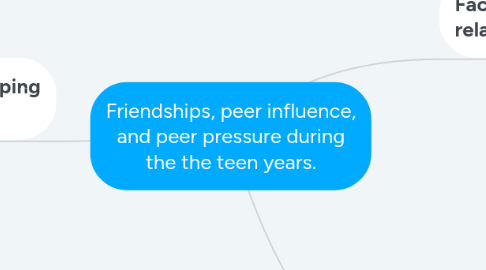
1. Effective Strategies for Coping with Peer Pressure.
1.1. Nurture teens' abilities and self - esteem so that they are equipped to foster positive peer relationships and deflect negative pressure.
1.2. Encourage positive relationships between significant adults and teens.
1.2.1. Youth can go to caring adults for help or advice about their peer relationships.
1.3. Encourage diverse relationships.
1.3.1. Schools and youth organizations can assist by encouraging youth from diverse backgrounds to work and play together
1.4. Support parent education programs for families with teenagers.
1.4.1. Parents need to be better informed about the dynamics of adolescent peer groups and the demand and expectations teenagers face in peer relationships.
1.4.2. Showing interests in issues of children might actually show your teens that you are concerned about them.
1.5. Equip youth with the skills necessary to resist negative behaviors, as well as to make good decision.
1.5.1. Teaching children to look at both the negative and positive sides to making a decision
1.6. Teaching youth exit strategies or ways to say "no" to negative pressure.
1.6.1. Try to deal with peer - pressure before it even happens.
1.6.2. It is helpful to think about these situations ahead of time rather than dealing with them as they occur or trying to recover after they happens
2. Facts about the teen - parent relationship during teen years.
2.1. Parent relationships are not necessarily undermined by peer relationships.
2.2. Parents continue to be the most influential factor in their lives.
2.2.1. Peers consider parents as being highly significant and influential in their lives.
2.2.2. Teens who have positive relationships with parents tend to have healthy friendships.
2.3. A vast number of conflicts do exist between adolescents an parents during childhood and early adolescence.
2.3.1. Parents should included adolescents in decision - making and rule - setting of their lives.
2.4. Parents who keep talking with children even when there are disagreements maintain closer relationship.
2.4.1. Parents should try to communicate with their children rather than avoiding disagreements.
3. Facts about peer friendship.
3.1. Teens often have a great number of layers and groups of friends.
3.2. Peer friendships are dynamic.
3.2.1. Peers friendship tend to be easily changing
3.3. Peers tend to choose friends who are in common with them
3.3.1. Teens seem to gravitate towards those who are more similar to them (eg. Gender, age, interests,...)
3.4. Peer friendships can be a healthy venue for positive youth development.
3.4.1. Peer friendships can be a safe place for youth to explore their identity, learn about social norms, and pratice their their autonomy.
3.4.2. Peers also can provide adolescents with social support for dealing with some of the challenges of adolescence.
